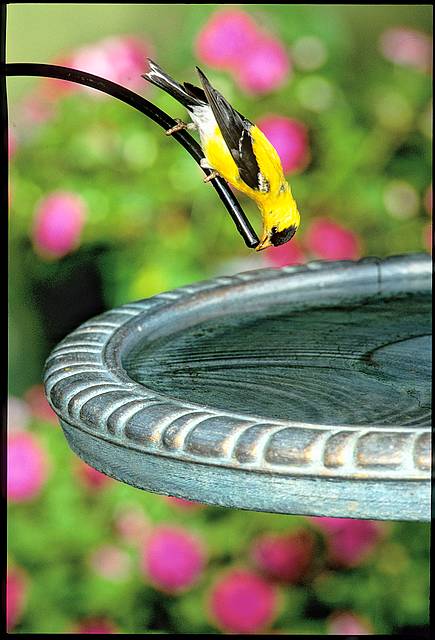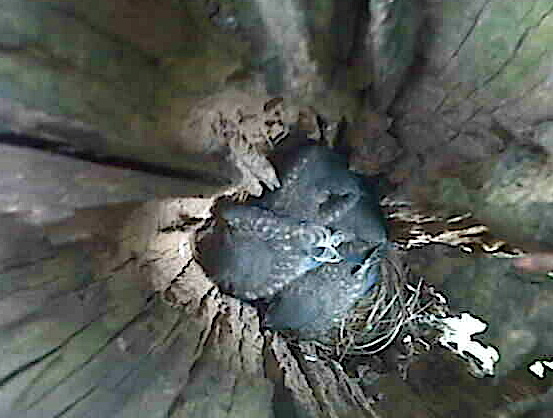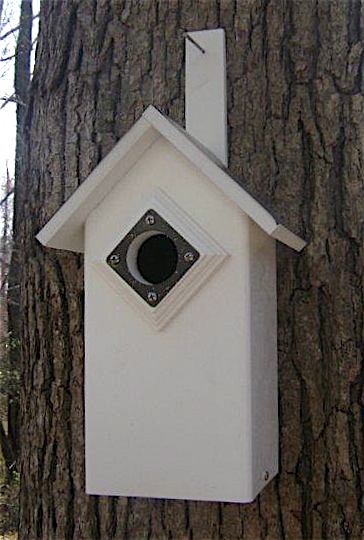-
a very cool hanging bird bath indeed!
 Although birds tend to bathe naturally at ground level, they usually flock to other fresh water sources too. A hanging bird bath is the perfect choice for smaller spaces, or yards where ground predators (cats) tend to lurk.
Although birds tend to bathe naturally at ground level, they usually flock to other fresh water sources too. A hanging bird bath is the perfect choice for smaller spaces, or yards where ground predators (cats) tend to lurk.Fresh water in a bird bath is hands down, one of the best ways to entice more species to your place. If that fresh water happens to be moving… well, it’s like a visual magnet for wild birds! Accessories like water wigglers, leaf misters, and bird bath fountains will absolutely increase the activity around any bath. Hummingbirds for example, are extremely fond of bird bath fountains and bubblers. They can be seen playing and bathing in them on a daily basis if they’re already feeding in your yard.
Leaf misters are adored by butterflies and many songbirds too, including bluebirds. The misters are versatile, and may be attached to a plant stake, or a branch, or even a deck or porch with an over-hanging bracket. This hanging bird bath features a solar power mister that’s built right in. The valve is adjustable, so that on windier days a stronger flow or fountain may be used, as opposed to the gentle mist.
Moving water really does attract more birds! This season consider adding some type of water feature to your yard, then sit back and see the difference while helping wild birds thrive.
p.s. use code BB10 at checkout for 10% off any bird bath or bath accessories
good through April 30th 2011. -
habitat and thistle feeders for Goldfinches
 Although American Goldfinches are a rather common songbird, it’s a favorite of many backyard birders. With a nickname of “yellow canary” the summer plumage of male Goldfinches is almost electric! Keeping thistle feeders out year-round will almost ensure that vibrant yellow color will grace your yard in warmer months.
Although American Goldfinches are a rather common songbird, it’s a favorite of many backyard birders. With a nickname of “yellow canary” the summer plumage of male Goldfinches is almost electric! Keeping thistle feeders out year-round will almost ensure that vibrant yellow color will grace your yard in warmer months.Habitat plays an important role in attracting any wildlife, and sometimes doing less work is better than doing more. Dandelions happen to be a favorite of goldfinches’, as are spent marigolds, cosmos, zinnias and coneflowers. Don’t dead-head these flowers, better off to leave them as treats for birds to feast.
Water is another key element in attracting finches or any wildlife for that matter. Fresh water in a birdbath will always provide an excellent resource for my species of birds. Keep a fresh water source near thistle feeders to further entice Goldfinches to your place.
Because their nesting and breeding starts so late in the season, you can expect a great increase of activity at thistle feeders in July and August. Parents feed chicks thistle exclusively, so feeders can get rather crowded. And because of their sweet nature, a Goldfinch is more likely to fly away from a crowded thistle feeder than to fight for a perch. If you’d like to attract these super-sweet songbirds, you may want to consider adding an extra thistle feeder in your yard this season.
-
some cool blue bird houses to last a lifetime

baby bluebirds grow up in a fence post at the farm  With a severe shortage in natural nesting places, bluebirds will appreciate decent diggs to nest and raise their young. With increasing development from strip malls to subdivisions snuffing out habitat, competition from non-native species also plays a huge part in this shortage of nest spots.
With a severe shortage in natural nesting places, bluebirds will appreciate decent diggs to nest and raise their young. With increasing development from strip malls to subdivisions snuffing out habitat, competition from non-native species also plays a huge part in this shortage of nest spots.You can provide proper housing in high style, with blue bird houses that will never rot, fade or warp with weather and time. More than just wood, materials like vinyl, ceramics and stoneware make for fantastic blue bird houses that are handcrafted to last a lifetime. This Vinyl Cottage Bluebird House happens to be NABS (North American Bluebird Society) approved. Complete with a metal predator guard, it helps protect eggs and nestlings from predators like cats, raccoons, and larger birds.

On a more artistic note, handcrafted stoneware blue bird houses can provide an interesting focal point in the landscape, while providing a proper nest site for blue birds. Stoneware is also inert, meaning it will not rot, is totally insect proof and guarantees to be around for a lifetime.
Help bluebirds thrive and flourish by erecting blue bird houses in your yard. You can entice them with suet and heated birdbaths in winter, and of course their favorite food any time of year… live mealworms! If you’re lucky enough to have more than one successful brood, it’s a real joy and pleasure to watch juveniles from the first brood help raise the new chicks and teach them to hunt.
